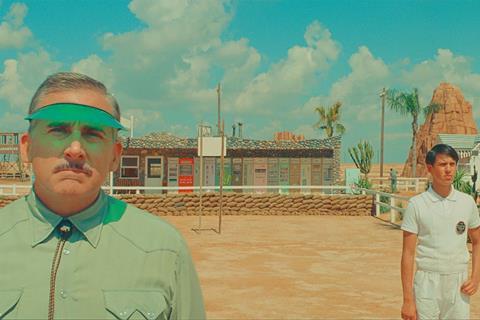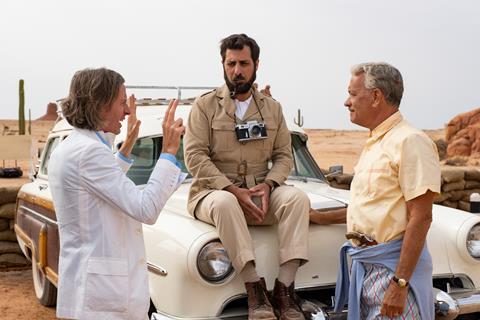Wes Anderson wanted to create an oasis somewhere in Europe to make his 1950s-era Cannes Competition title. He found it in Spain, just 15 miles from Madrid.

Rye, garlic, olives and melons are now growing back in the agricultural flatlands that were cleared in the summer of 2021 for the shoot for Wes Anderson’s Competition title Asteroid City. The area between the small Spanish towns of Chinchon and Colmenar de Oreja, southeast of Madrid, was transformed into the fictitious city in the heart of the American West circa 1955, complete with red sand desert, period cars and colourful building facades. Anderson, who is based in France, wanted to shoot in Europe.
“We had very specific specifications,” says producer Jeremy Dawson, a long-time Anderson collaborator. “We needed good weather and big blue skies because we were going to shoot mainly outdoors. Flat terrain, a clear horizon and a set close to where cast and crew could stay. We also wanted to shoot somewhere with a tax credit.”
The production looked at other places in Europe, including Italy, but Spain was the best fit. “It is a great place to shoot and the right scale, not too big that it takes you a long time to access a location from the airports,” Dawson says. “In the US, if you shoot in the desert, the closest hotel can be 100 miles away. The local crew was also very professional. They know how to make films. Everything went according to plan.”
Asteroid City is produced by Anderson, Dawson and Steven Rales, founder of production company Indian Paintbrush. The cast includes Jason Schwartzman, Scarlett Johansson, Tom Hanks, Jeffrey Wright, Tilda Swinton, Bryan Cranston, Maya Hawke, Steve Carell, Matt Dillon and Margot Robbie. It will be distributed next month in the US by Focus Features and internationally by Universal Pictures International. The international crew included regular Anderson heads of departments, costume designer Milena Canonero, production designer Adam Stockhausen and cinematographer Robert D Yeoman.
Negotiations to secure the land to build the city set started in autumn 2020. “It was not just one piece of land, it was many and they belonged to different people, different families,” recalls Dawson. “We had to get them to agree to rent them at the same time and not have one guy left in the middle with his watermelon field.”
To achieve the look of an American mesa, the ground was covered with red soil, with the full agreement of farmers and in compliance with environmental shooting directives to ensure no damage to future crops.
Local liaison

Fernando Victoria de Lecea, CEO of Spanish service company Meñakoz Films was the key liaison with the local community (the company was recommended by Canonero from previous work together on Jacques Audiard’s The Sisters Brothers).
“To get the 60 hectares we needed we had to deal with 140 landowners, farmers that do not necessarily know about the film industry,” says De Lecea. “We rented the land for two years because they could not sow next year’s crop while we were filming. We did it all in time, analysing the soil to choose the right type of red earth to cover the surface with. We also had to remove the landmarks of the different properties.”
The production hired a topologist to map out the area and used GPS to identify the boundaries of each parcel of land once filming had wrapped. They also worked closely with the Spanish authorities and local film commissions throughout the process.
“It was during Covid and getting the visas for everybody to come meant a lot of work,” says Dawson, adding that the level of paperwork and red tape for Spain was on a par with France and Germany.
He recalls the Spanish shoot fondly. “We were a small crew in the middle of a plain,” he says. “No trucks, no trailers, no big camper vans. We used the motel cabins built for the occasion and they were air-conditioned. There were no dressing rooms. Everybody was living in the set from the moment they were on set.
“It was great to hang out in ‘Asteroid City’. Once the actors arrived, they would come and hang out even on the days they were not working. Suddenly you would see Tom Hanks there, just because he wanted to see what was going on.
“We picked almonds on the way to the set on bicycles,” Dawson continues. “We had dinner outside every night. It was Covid so we kept our bubble at the hotel. After a long day’s shooting, we would have a nice glass of wine, some pan con tomate and possibly too much jamon. It was a beautiful space to shoot.”























No comments yet